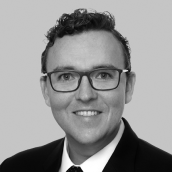
Dominic Volek, CA(SA), FIMC, is Group Head of Private Clients at Henley & Partners and a member of the Executive Committee.
Next year, it’s projected that 165,000 millionaires will be permanently relocating to new countries, moving families, businesses, and potentially billions in assets. The UK alone faces a forecast net loss of –16,500 millionaires in 2025, while the UAE looks set to welcome +9,800 new wealthy migrants from capitals such as London, Mumbai, Frankfurt, Paris, Moscow, and Beijing. Driving this global wealth migration is a robust infrastructure of investment migration programs, which now account for approximately 30% of all high-net-worth relocations worldwide.
The correlation between wealth destinations and investment migration programs tells the story: All of the Top 20 wealth inflow destinations in 2025 operate investor visa options. This infrastructure has evolved from emergency exits to primary planning tools, enabling families to execute complex multi-jurisdictional strategies that would have been impossible a generation ago. Faced with unprecedented volatility, investors and wealthy families are adopting a strategy of geopolitical arbitrage to acquire additional residence and/or citizenship options to hedge against jurisdictional risk and leverage the differences in legal, economic, political, and social conditions across countries to optimize their personal, financial, and lifestyle outcomes.
The data validates this evolution. Applications for investment migration programs processed by Henley & Partners surged 64% in Q1 2025 compared to Q1 2024, while enquiries jumped 53%. These represent calculated strategies. A UK non-domiciled resident facing new tax changes structures their exit through the UAE’s Golden Visa program, investing as little as AED 1 million to secure a five-year renewable residence permit. This legal framework transforms an emotional decision into an executable strategy, complete with timelines, investment structures, and succession planning.

The UAE’s dominance in attracting the highest net inflow of high-net-worth individuals in 2025 reflects more than its zero personal tax rates. As documented in an analysis of wealth hubs, Dubai has emerged as a strong magnet for private wealth through favorable tax policies and government support. The Emirates built an end-to-end ecosystem for wealth transition: streamlined visa processing, world-class banking infrastructure, and direct flights to every major financial center.
The Emirates’ Golden Visa program serves as the entry mechanism, with processing taking weeks rather than years. While UAE nationals rarely apply for programs elsewhere, the country hosts the second-highest number of program applicants at Henley & Partners globally after the USA, confirming its role as the world’s premier wealth hub for expatriates.
America ranks 2nd in net millionaire inflows, and its US EB-5 Immigrant Investor Program continues attracting record enquiries despite raising investment thresholds to USD 800,000 for targeted areas and USD 1.05 million for standard projects some years ago. The EB-5 remains the gateway for international families seeking access to the world’s deepest capital markets, top-tier universities, and entrepreneurial ecosystems.
In terms of top destinations for millionaires relocating to the USA, Florida is especially popular, combining tax advantages with Caribbean proximity. Silicon Valley remains the global technology capital, attracting founders who see the EB-5 as strategic gateway to accessing its unparalleled innovation ecosystem.
Italy’s ascent to 3rd place for net millionaire arrivals this year reflects calculated tax optimization, offering 4% estate duty compared to 30%+ rates across other major European economies. Italy’s Residence by Investment Program ranks among the top 10 most sought-after residence programs globally in 2025, based on the volume of applications and enquiries handled by Henley & Partners. Wealthy families from the USA and the UK, in particular, are increasingly leveraging the Italian residence route as part of long-term, cross-generational wealth preservation strategies. Milan’s financial sector growth and Liguria’s lifestyle enhance an already compelling fiscal proposition.
Ranking 7th and 8th, respectively, for attracting millionaires this year are Portugal and Greece. Portugal’s Golden Residence Permit Program remains the most enquired-about program globally, despite shifting from real estate to a EUR 500,000 investment in funds. This redirection of foreign capital towards productive assets maintains accessibility while serving national economic goals. The Greece Golden Visa Program’s EUR 250,000 real estate entry threshold — among Europe’s lowest — keeps it among the top programs for both applications and enquiries in 2025. Both countries benefit from EU membership, offering national residence with continental access.
The traditional immigration giants, Canada and Australia, share the 9th spot for net relocating millionaires, and both offer extremely sought-after residence program options. Canada’s Start-Up Visa Program continues to attract significant interest, ranking 4th overall for global enquiries we have received in 2025. Meanwhile Australia is enjoying renewed attention, with a surge in enquiries since launching its National Innovation Visa (NIV) program — a streamlined pathway to permanent residence for highly skilled and talented academics, global researchers, innovative investors and entrepreneurs, and world-renowned athletes, artists, and entertainers.
Neighboring New Zealand’s Active Investor Plus Visa Program has emerged as a surprise winner in recent months, becoming one of 2025’s top application destinations after April program changes saw the minimum investment being reduced to NZD 5 million, making it more attractive to global families.
Ultra-high-net-worth Asian families increasingly split operations between Hong Kong (SAR China) and Singapore, creating complementary positions that maximize opportunity while minimizing risk. This approach, documented in recent financial sector analysis, sees wealthy Chinese and Indian families “spreading their wealth across the region’s best-known financial hubs — Hong Kong and Singapore — in order to diversify risk and access a wider range of services.”
Singapore, which is expected to see a net influx of +1,600 new millionaires in 2025, provides political neutrality, sophisticated private banking, and Southeast Asian growth exposure. The city-state’s transparent approach to family office licensing attracts those seeking clarity and stability. Families can formally apply for tax exemptions through a clear process that verifies backgrounds, source of wealth, and structural robustness.
Hong Kong (SAR China), which is forecast to receive a net inflow of +800 migrating millionaires by year-end, offers proximity to China’s USD 18.8 trillion economy, deep capital markets, and North Asian connectivity. Its family office tax concessions, available through self-declaration after one year of operations, provide flexibility for families already operating in the region. Despite geopolitical concerns, Hong Kong ranked among the world’s top four IPO venues in 2024, raising HKD 83 billion from 66 new listings.
The numbers underscore this dual approach. Single-family offices across both cities quadrupled since 2020, reaching 4,000 entities managing approximately USD 5.8 trillion in intergenerational wealth transfer through to 2030. Both also offer residence pathways for wealthy investors. The Singapore Global Investor Program is aimed at entrepreneurs or investors interested in making substantial financial investments in the ‘Lion City’ and making it their home, while Hong Kong’s Visa Programs include the Capital Investment Entrant Scheme (CIES) for individuals who invest a minimum of HKD 30 million in Hong Kong equities, real estate, or other qualifying portfolios.
Today’s investment migration clients construct sovereign portfolios where each residence and citizenship serves a specific function. Caribbean programs — with Grenada, Antigua and Barbuda, and St. Kitts and Nevis ranking among 2025’s top five application destinations — provide visa-free travel benefits and efficient processing times. European programs offer lifestyle, education, and business access as well as travel mobility in Europe’s Schengen Area. The surge in demand for Thailand’s Long Term Residence Program reflects growing interest in Asian bases beyond traditional hubs.
This sophisticated approach to portfolio construction finds its fullest expression in the Henley Ultimate Portfolio, which enables ultra-high-net-worth investors to acquire multiple complementary residences and citizenships through a single, streamlined application process. The platform’s interactive interface allows families to compare what their current nationalities offer with up to four additional investment migration programs based on 35 unique indicators, optimizing their global access and jurisdictional advantages.
Our data reveals sophisticated planning patterns. UK applications increased 183% in Q1 2025, with British nationals now representing the sixth-largest source market as families execute exits ahead of tax changes. German applications grew 33% in 2024, with 2025 tracking towards similar growth, reflecting broader European wealth redistribution. The correlation is clear: countries experiencing the largest net millionaire outflows — the UK, India, and China — also generate among the highest application volumes for investment migration programs.
This movement reflects the maturation of investment migration from insurance to architecture. Families now acquire multiple programs to build multi-jurisdictional structures. A typical portfolio might include Portuguese residence for EU access, Caribbean citizenship for travel flexibility, and UAE residence for tax efficiency — each component serving distinct strategic purposes while creating optionality for future generations.
The 2025 wealth migration data captures a structural shift in how wealth organizes itself globally. All Top 10 destinations for relocating millionaires operate investment-based residence programs: the UAE, the USA, Italy, Switzerland, Saudi Arabia, Singapore, Portugal, Greece, Canada, and Australia. These programs succeed by offering frameworks for executing complex, multi-generational strategies.
The surge in both global applications and enquiries — 64% and 53% respectively in Q1 2025 compared to the same period last year — demonstrates that wealthy families increasingly view residence and citizenship rights as essential portfolio components rather than luxury purchases.
In this new architecture, investment migration has evolved from facilitator to foundation. The battle for wealth hubs favors jurisdictions that recognize today’s global wealthy require seamless access to multiple markets, tax optimization across borders, and succession planning that transcends nationality. Investment migration programs have become the blueprint for building multi-jurisdictional wealth structures that define 21st-century capital mobility.